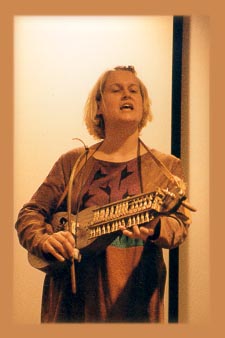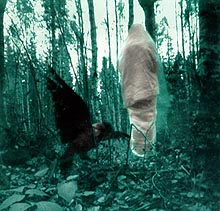TELLU
 For many generations the ideas, feelings and heroic folk-tales of Finland were passed on in songs now known as runo-songs, poem-songs. Their lyrics, in four-footed trochaic metre, went with a short melody, within a limited compass of usually only a fifth, repeated over and over with slight variations. In the last century Elias L�nnrot put together and adapted some of the thousands of verses that he and others had collected, to make the Kalevala, a work which refocused Finns on their own language and culture and became a totem in the move to independence. Poets outside Finland picked up on the metre; Longfellow used it and the idea of a heroic epic to make Hiawatha.
For many generations the ideas, feelings and heroic folk-tales of Finland were passed on in songs now known as runo-songs, poem-songs. Their lyrics, in four-footed trochaic metre, went with a short melody, within a limited compass of usually only a fifth, repeated over and over with slight variations. In the last century Elias L�nnrot put together and adapted some of the thousands of verses that he and others had collected, to make the Kalevala, a work which refocused Finns on their own language and culture and became a totem in the move to independence. Poets outside Finland picked up on the metre; Longfellow used it and the idea of a heroic epic to make Hiawatha.
But now that old runo-song is on the move again, the songs once more being created and used to express living ideas, and it's being greeted with rapt attention and enthusiasm by the new and youngest wave of Finland's musical tradition, who packed the Kaustinen Festival shows of Tellu Virkkala's Suden Aika (Time Of The Wolf).
It's a 35-minute piece, sung by Tellu (who left Hedningarna at the end of June, 1996), fellow Hedningarna singer Sanna Kurki-Suonio, Liisa Matveinen (ex-Tallari) and her successor in Tallari and Me Naiset member Pia Rask. Nine songs, a combination of tradition reworked and her own composition both musical and lyrical, tell, in that elusive, oblique way of the old songs, a procession of rich images for the hearer to link rather than step-by-step narrative, Tellu's story of a woman's birth, deception and marital imprisonment, escape and wandering, and final gaining of some kind of peace of mind.
"If you think about Kalevala - Elias L�nnrot wrote it, but it was gathered together from smaller stories, and it's very ... man's stuff. Heroic stories, wars, fights. There aren't many women's songs in it - there are some, but most of the main stories are very man-oriented. That's one of the reasons why I did Suden Aika - to be a women's story."
The title derives from a book by American writer Clarissa Pinkola Estes. "It's a fairy-tale analysis, called "Women Who Run With The Wolves"; it's about how every woman should find the wolf inside." Is there enough material with a woman's viewpoint in the collections to work with? "Certainly there is, in Suomen Kansan Vanhat Runot - the big collection, over 30 books, there is lots of women's stuff, and you could collect dozens of feminine Kalevalas from it - so I've only just started!"
 The piece is musically powerful whether or not one understands the lyrics. Sometimes it's a solo voice, sometimes all four, sometimes caressing and soft, sometimes hard and chattering, using vocal techniques from the four's deep grounding in Finnish tradition and occasionally borrowing from others - a snatch of Scandinavian herding call, a hint of pygmy vocalising.
The piece is musically powerful whether or not one understands the lyrics. Sometimes it's a solo voice, sometimes all four, sometimes caressing and soft, sometimes hard and chattering, using vocal techniques from the four's deep grounding in Finnish tradition and occasionally borrowing from others - a snatch of Scandinavian herding call, a hint of pygmy vocalising.
Are there any influences from Sami joiku? "I know so very little about joiku and I don't have any connection with it. Except I suppose maybe it has influenced me in using sounds like "lo-lei-la" in the backing vocals!"
The contrasting tone colours and way in which the voices wind around one another in rhythmic interplay and unite in harmony in Tellu's arrangements widen the music and seem at first hearing to take it far from those basic runo-tunes, but they're always still there.
"It has to have the ground all the time. It's more like minimal music - it floats, and changes on the way like a river, and perhaps comes back. Whether or where it builds to a climax depends on the text, where the high points are."
"I've been trying to paint a picture with the arrangements and the tunes, to underline the text so foreigners too can get pictures in their head about what I'm singing."
In Finnish traditional music improvisation has much more of a role than it does in, say, most Celtic music, and there's some of it here. "Yes; for example in the long solo, I hardly ever sing it twice the same. It's the small details I change - one note here or, there, some ornaments. It doesn't sound good in my ears if you change too much."
When, with Sanna, Tellu joined Hedningarna it was primarily as a fiddler, but once in the band she found herself doing a lot of singing and discovered her love of it. Both of them were still at Sibelius Academy, in fact were still at an early stage in their course, which lasts about six years, in the remarkable Folk Music Department. Tellu's studies took her for a year to Norway to work with the Hardanger fiddle, and her singing is influenced by her instrumental work..
"I've noticed that it has had lots of unconscious influence on my song - ornaments and so on. Ritva Talvitie (who plays fiddle in Tallari), when she heard Suden Aika, said 'Yes, you can hear immediately that you're a fiddler!'"
This year's Kaustinen shows were, like several of the most magical moments, entirely acoustic, with no PA, but clearly there will be times when that's not possible. "Laulutupa yesterday was quite frustrating, because it was so full and so the acoustic was so dry we had difficulties hearing each another. Then we felt like we would have needed some PA. I want to make it work in both ways - in bigger places with a PA too and still keep it intimate and interesting."
The show will go on; "I want to continue with this, do some more concerts and see what happens. I've been thinking about making it bigger, composing more tunes to make it an hour long. And I have been dreaming that if people get interested and we get paid enough I can afford to have Tina in some concerts." (Tina Johansson played percussion on the album, but she lives in Sweden.) "One idea I had for making the concert bigger - not bigger in terms of larger halls, but a bigger show - is to get the audience to sing with me. And I want to make more, long stories that I sing myself. Like Heikki Laitinen has been doing, singing an hour-long story. That's something I want to learn more about." - Andrew Cronshaw
The recorded version of Suden Aika, with excellent English translations by Rauni Kanerva written in Kalevala metre, is published by Kansanmusiikki-instituutti and is available at CDRoots
Performance photo by Cliff Furnald, 1998
All other images are from the album cover and notes, © Kansanmusiikki-instituutti